Dissertation: Technology in Project Life Cycle - UAE Construction
VerifiedAdded on 2023/01/07
|69
|15927
|87
Thesis and Dissertation
AI Summary
This dissertation investigates the relationship between advanced technology and the UAE construction industry, employing a deductive research methodology with questionnaires based on the Likert scale and data analysis using SPSS software. The research explores the impact of technology on project life cycle management. The findings reveal no direct relationship between the variables, but indicate low to moderate correlations and highlight challenges like employee management during technology implementation. The study also identifies numerous benefits, such as improved performance and a more robust working environment. The dissertation covers project life cycle management, various technologies used (including Virtual Prototyping, AI, BIM, and VR), their benefits, and associated challenges, offering recommendations to overcome these issues and enhance organizational performance. The structure includes an introduction, literature review, research methodology, findings, discussion, and conclusion with recommendations. The research aims to examine the use of technology in project life cycle management within the UAE construction industry.

Dissertation
Paraphrase This Document
Need a fresh take? Get an instant paraphrase of this document with our AI Paraphraser
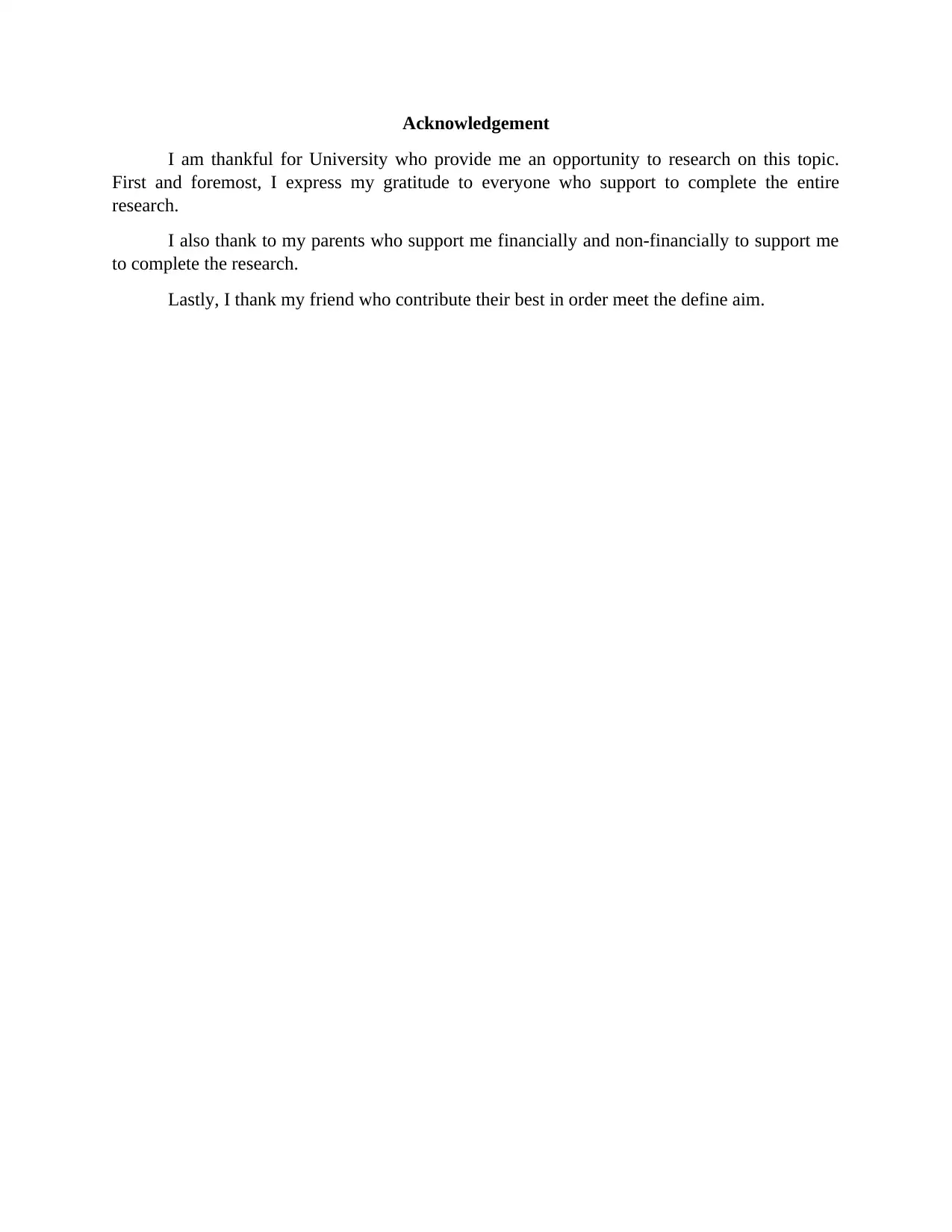
Acknowledgement
I am thankful for University who provide me an opportunity to research on this topic.
First and foremost, I express my gratitude to everyone who support to complete the entire
research.
I also thank to my parents who support me financially and non-financially to support me
to complete the research.
Lastly, I thank my friend who contribute their best in order meet the define aim.
I am thankful for University who provide me an opportunity to research on this topic.
First and foremost, I express my gratitude to everyone who support to complete the entire
research.
I also thank to my parents who support me financially and non-financially to support me
to complete the research.
Lastly, I thank my friend who contribute their best in order meet the define aim.
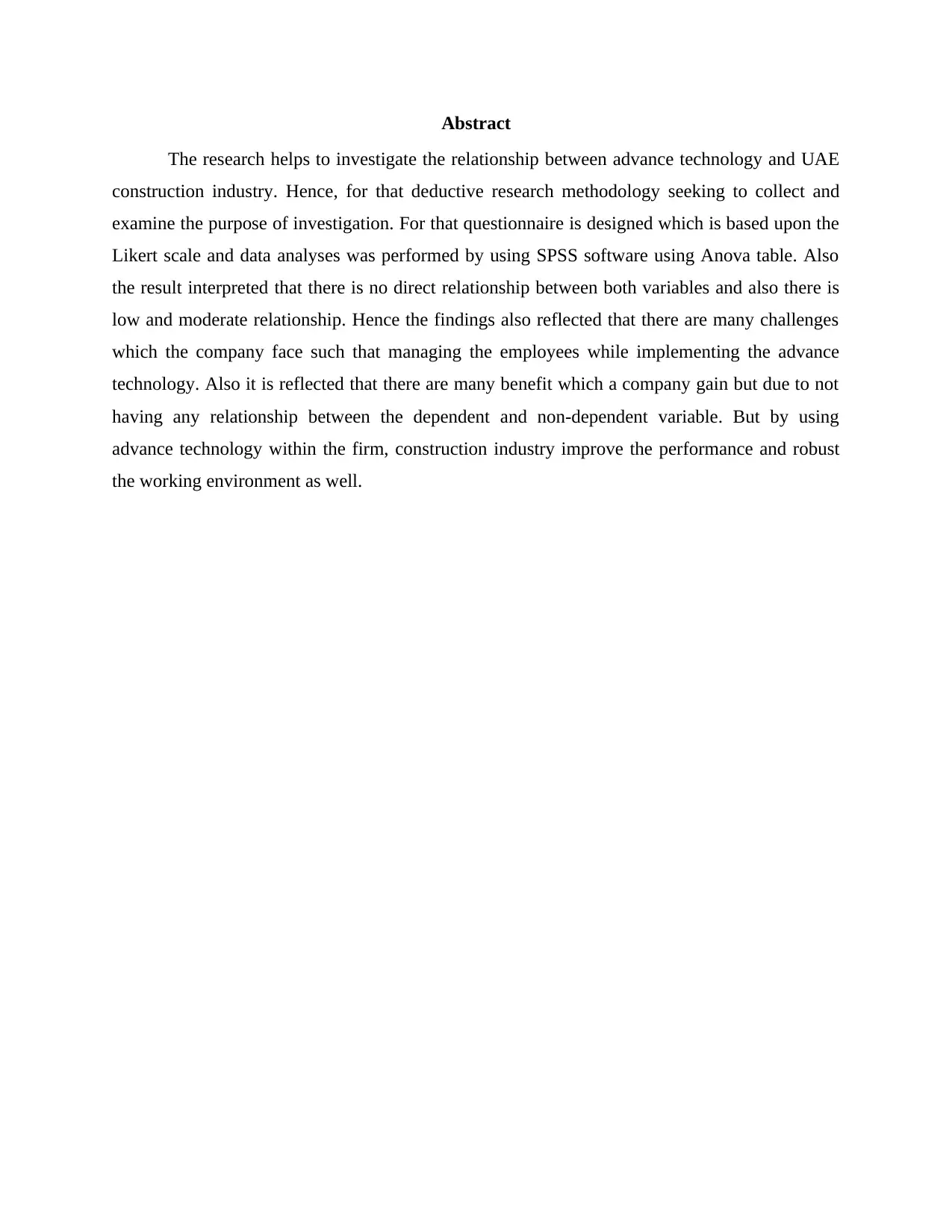
Abstract
The research helps to investigate the relationship between advance technology and UAE
construction industry. Hence, for that deductive research methodology seeking to collect and
examine the purpose of investigation. For that questionnaire is designed which is based upon the
Likert scale and data analyses was performed by using SPSS software using Anova table. Also
the result interpreted that there is no direct relationship between both variables and also there is
low and moderate relationship. Hence the findings also reflected that there are many challenges
which the company face such that managing the employees while implementing the advance
technology. Also it is reflected that there are many benefit which a company gain but due to not
having any relationship between the dependent and non-dependent variable. But by using
advance technology within the firm, construction industry improve the performance and robust
the working environment as well.
The research helps to investigate the relationship between advance technology and UAE
construction industry. Hence, for that deductive research methodology seeking to collect and
examine the purpose of investigation. For that questionnaire is designed which is based upon the
Likert scale and data analyses was performed by using SPSS software using Anova table. Also
the result interpreted that there is no direct relationship between both variables and also there is
low and moderate relationship. Hence the findings also reflected that there are many challenges
which the company face such that managing the employees while implementing the advance
technology. Also it is reflected that there are many benefit which a company gain but due to not
having any relationship between the dependent and non-dependent variable. But by using
advance technology within the firm, construction industry improve the performance and robust
the working environment as well.
⊘ This is a preview!⊘
Do you want full access?
Subscribe today to unlock all pages.

Trusted by 1+ million students worldwide
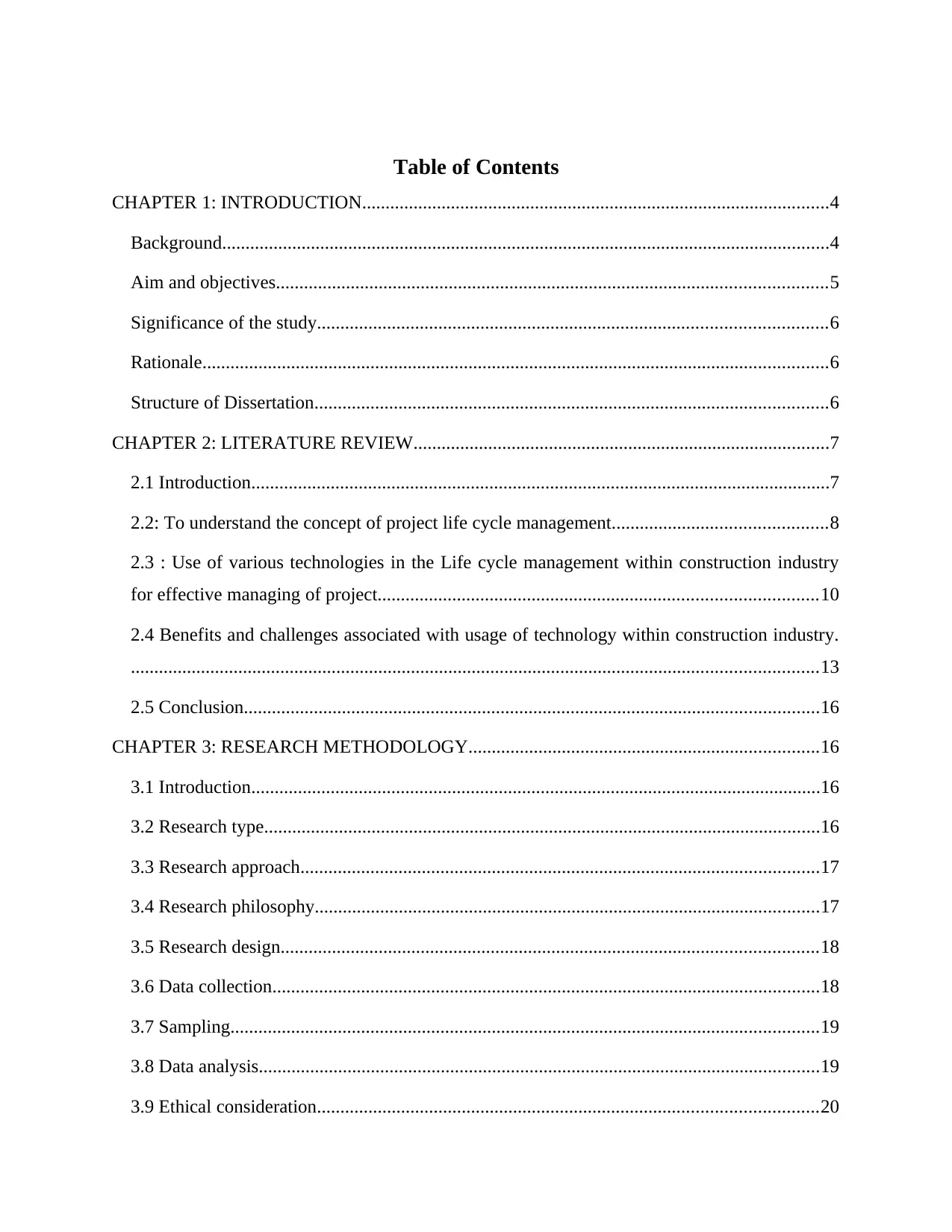
Table of Contents
CHAPTER 1: INTRODUCTION....................................................................................................4
Background..................................................................................................................................4
Aim and objectives......................................................................................................................5
Significance of the study.............................................................................................................6
Rationale......................................................................................................................................6
Structure of Dissertation..............................................................................................................6
CHAPTER 2: LITERATURE REVIEW.........................................................................................7
2.1 Introduction............................................................................................................................7
2.2: To understand the concept of project life cycle management..............................................8
2.3 : Use of various technologies in the Life cycle management within construction industry
for effective managing of project..............................................................................................10
2.4 Benefits and challenges associated with usage of technology within construction industry.
...................................................................................................................................................13
2.5 Conclusion...........................................................................................................................16
CHAPTER 3: RESEARCH METHODOLOGY...........................................................................16
3.1 Introduction..........................................................................................................................16
3.2 Research type.......................................................................................................................16
3.3 Research approach...............................................................................................................17
3.4 Research philosophy............................................................................................................17
3.5 Research design...................................................................................................................18
3.6 Data collection.....................................................................................................................18
3.7 Sampling..............................................................................................................................19
3.8 Data analysis........................................................................................................................19
3.9 Ethical consideration...........................................................................................................20
CHAPTER 1: INTRODUCTION....................................................................................................4
Background..................................................................................................................................4
Aim and objectives......................................................................................................................5
Significance of the study.............................................................................................................6
Rationale......................................................................................................................................6
Structure of Dissertation..............................................................................................................6
CHAPTER 2: LITERATURE REVIEW.........................................................................................7
2.1 Introduction............................................................................................................................7
2.2: To understand the concept of project life cycle management..............................................8
2.3 : Use of various technologies in the Life cycle management within construction industry
for effective managing of project..............................................................................................10
2.4 Benefits and challenges associated with usage of technology within construction industry.
...................................................................................................................................................13
2.5 Conclusion...........................................................................................................................16
CHAPTER 3: RESEARCH METHODOLOGY...........................................................................16
3.1 Introduction..........................................................................................................................16
3.2 Research type.......................................................................................................................16
3.3 Research approach...............................................................................................................17
3.4 Research philosophy............................................................................................................17
3.5 Research design...................................................................................................................18
3.6 Data collection.....................................................................................................................18
3.7 Sampling..............................................................................................................................19
3.8 Data analysis........................................................................................................................19
3.9 Ethical consideration...........................................................................................................20
Paraphrase This Document
Need a fresh take? Get an instant paraphrase of this document with our AI Paraphraser
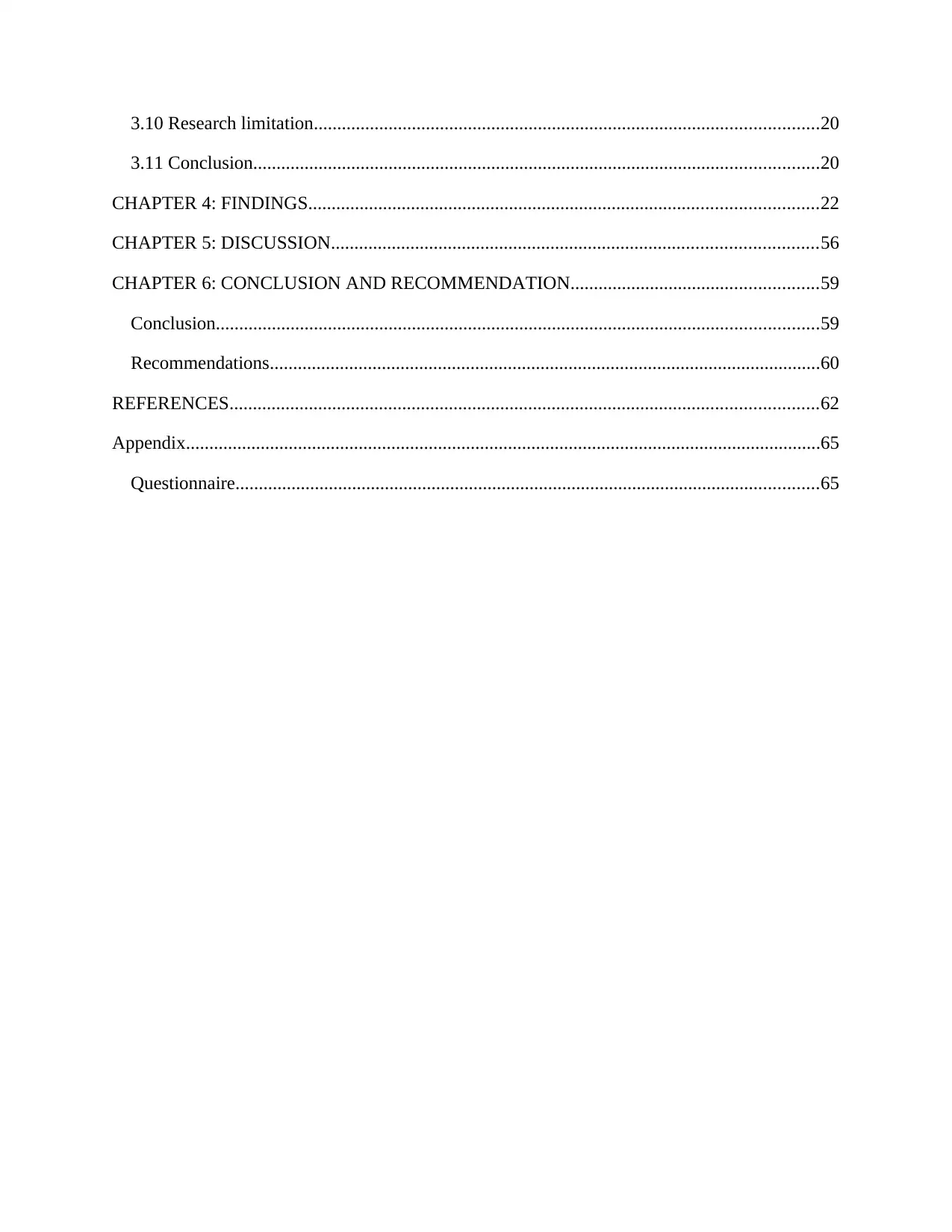
3.10 Research limitation............................................................................................................20
3.11 Conclusion.........................................................................................................................20
CHAPTER 4: FINDINGS.............................................................................................................22
CHAPTER 5: DISCUSSION........................................................................................................56
CHAPTER 6: CONCLUSION AND RECOMMENDATION.....................................................59
Conclusion.................................................................................................................................59
Recommendations......................................................................................................................60
REFERENCES..............................................................................................................................62
Appendix........................................................................................................................................65
Questionnaire.............................................................................................................................65
3.11 Conclusion.........................................................................................................................20
CHAPTER 4: FINDINGS.............................................................................................................22
CHAPTER 5: DISCUSSION........................................................................................................56
CHAPTER 6: CONCLUSION AND RECOMMENDATION.....................................................59
Conclusion.................................................................................................................................59
Recommendations......................................................................................................................60
REFERENCES..............................................................................................................................62
Appendix........................................................................................................................................65
Questionnaire.............................................................................................................................65
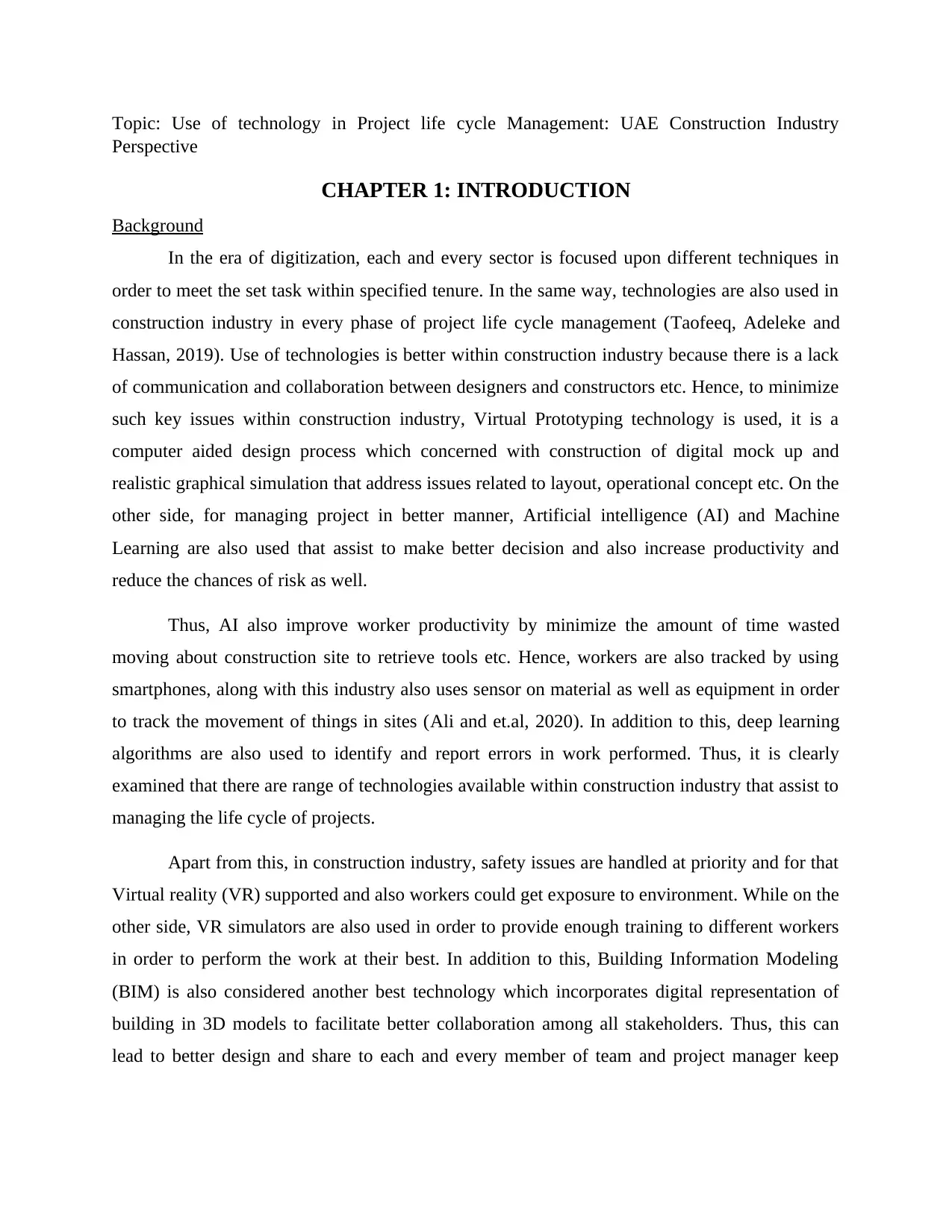
Topic: Use of technology in Project life cycle Management: UAE Construction Industry
Perspective
CHAPTER 1: INTRODUCTION
Background
In the era of digitization, each and every sector is focused upon different techniques in
order to meet the set task within specified tenure. In the same way, technologies are also used in
construction industry in every phase of project life cycle management (Taofeeq, Adeleke and
Hassan, 2019). Use of technologies is better within construction industry because there is a lack
of communication and collaboration between designers and constructors etc. Hence, to minimize
such key issues within construction industry, Virtual Prototyping technology is used, it is a
computer aided design process which concerned with construction of digital mock up and
realistic graphical simulation that address issues related to layout, operational concept etc. On the
other side, for managing project in better manner, Artificial intelligence (AI) and Machine
Learning are also used that assist to make better decision and also increase productivity and
reduce the chances of risk as well.
Thus, AI also improve worker productivity by minimize the amount of time wasted
moving about construction site to retrieve tools etc. Hence, workers are also tracked by using
smartphones, along with this industry also uses sensor on material as well as equipment in order
to track the movement of things in sites (Ali and et.al, 2020). In addition to this, deep learning
algorithms are also used to identify and report errors in work performed. Thus, it is clearly
examined that there are range of technologies available within construction industry that assist to
managing the life cycle of projects.
Apart from this, in construction industry, safety issues are handled at priority and for that
Virtual reality (VR) supported and also workers could get exposure to environment. While on the
other side, VR simulators are also used in order to provide enough training to different workers
in order to perform the work at their best. In addition to this, Building Information Modeling
(BIM) is also considered another best technology which incorporates digital representation of
building in 3D models to facilitate better collaboration among all stakeholders. Thus, this can
lead to better design and share to each and every member of team and project manager keep
Perspective
CHAPTER 1: INTRODUCTION
Background
In the era of digitization, each and every sector is focused upon different techniques in
order to meet the set task within specified tenure. In the same way, technologies are also used in
construction industry in every phase of project life cycle management (Taofeeq, Adeleke and
Hassan, 2019). Use of technologies is better within construction industry because there is a lack
of communication and collaboration between designers and constructors etc. Hence, to minimize
such key issues within construction industry, Virtual Prototyping technology is used, it is a
computer aided design process which concerned with construction of digital mock up and
realistic graphical simulation that address issues related to layout, operational concept etc. On the
other side, for managing project in better manner, Artificial intelligence (AI) and Machine
Learning are also used that assist to make better decision and also increase productivity and
reduce the chances of risk as well.
Thus, AI also improve worker productivity by minimize the amount of time wasted
moving about construction site to retrieve tools etc. Hence, workers are also tracked by using
smartphones, along with this industry also uses sensor on material as well as equipment in order
to track the movement of things in sites (Ali and et.al, 2020). In addition to this, deep learning
algorithms are also used to identify and report errors in work performed. Thus, it is clearly
examined that there are range of technologies available within construction industry that assist to
managing the life cycle of projects.
Apart from this, in construction industry, safety issues are handled at priority and for that
Virtual reality (VR) supported and also workers could get exposure to environment. While on the
other side, VR simulators are also used in order to provide enough training to different workers
in order to perform the work at their best. In addition to this, Building Information Modeling
(BIM) is also considered another best technology which incorporates digital representation of
building in 3D models to facilitate better collaboration among all stakeholders. Thus, this can
lead to better design and share to each and every member of team and project manager keep
⊘ This is a preview!⊘
Do you want full access?
Subscribe today to unlock all pages.

Trusted by 1+ million students worldwide
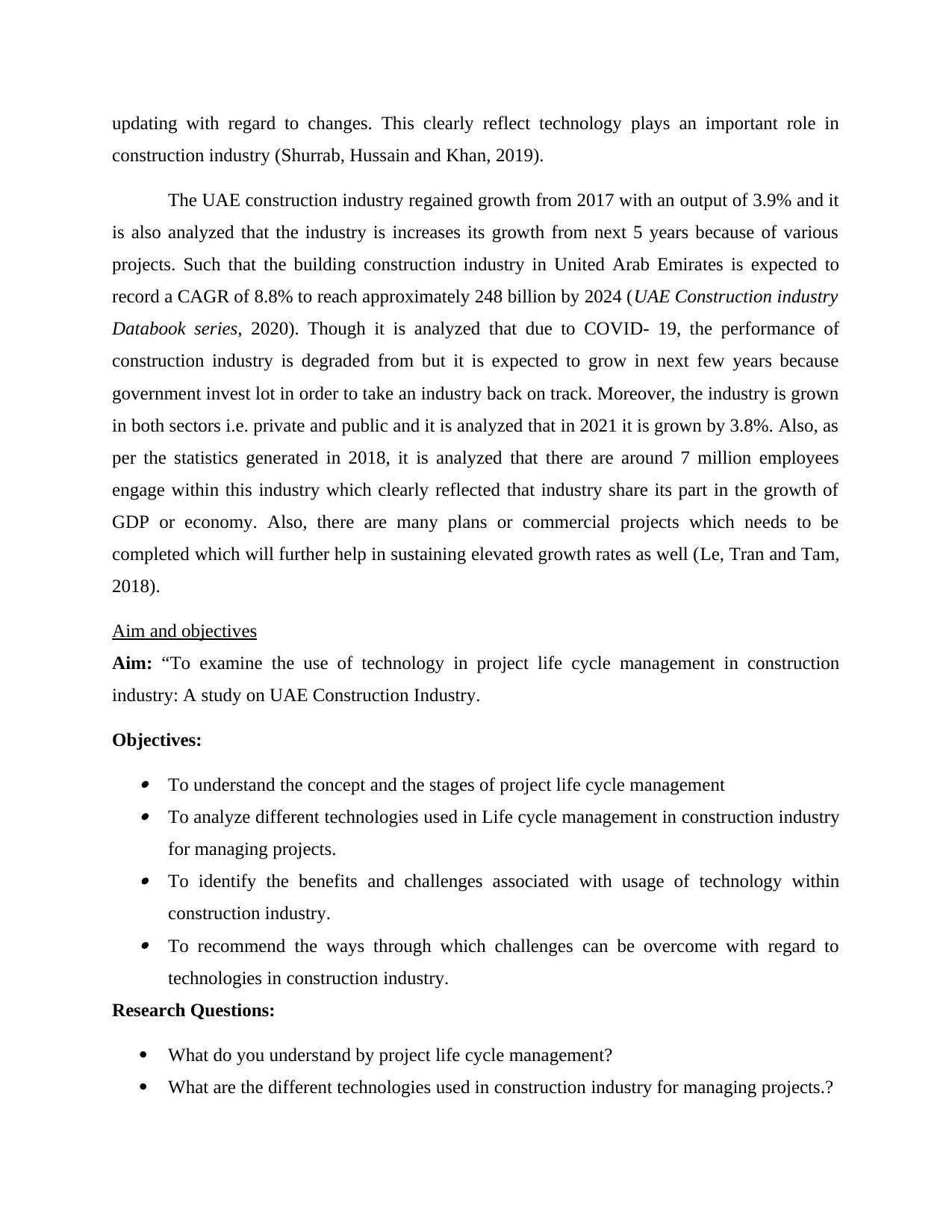
updating with regard to changes. This clearly reflect technology plays an important role in
construction industry (Shurrab, Hussain and Khan, 2019).
The UAE construction industry regained growth from 2017 with an output of 3.9% and it
is also analyzed that the industry is increases its growth from next 5 years because of various
projects. Such that the building construction industry in United Arab Emirates is expected to
record a CAGR of 8.8% to reach approximately 248 billion by 2024 (UAE Construction industry
Databook series, 2020). Though it is analyzed that due to COVID- 19, the performance of
construction industry is degraded from but it is expected to grow in next few years because
government invest lot in order to take an industry back on track. Moreover, the industry is grown
in both sectors i.e. private and public and it is analyzed that in 2021 it is grown by 3.8%. Also, as
per the statistics generated in 2018, it is analyzed that there are around 7 million employees
engage within this industry which clearly reflected that industry share its part in the growth of
GDP or economy. Also, there are many plans or commercial projects which needs to be
completed which will further help in sustaining elevated growth rates as well (Le, Tran and Tam,
2018).
Aim and objectives
Aim: “To examine the use of technology in project life cycle management in construction
industry: A study on UAE Construction Industry.
Objectives: To understand the concept and the stages of project life cycle management To analyze different technologies used in Life cycle management in construction industry
for managing projects. To identify the benefits and challenges associated with usage of technology within
construction industry. To recommend the ways through which challenges can be overcome with regard to
technologies in construction industry.
Research Questions:
What do you understand by project life cycle management?
What are the different technologies used in construction industry for managing projects.?
construction industry (Shurrab, Hussain and Khan, 2019).
The UAE construction industry regained growth from 2017 with an output of 3.9% and it
is also analyzed that the industry is increases its growth from next 5 years because of various
projects. Such that the building construction industry in United Arab Emirates is expected to
record a CAGR of 8.8% to reach approximately 248 billion by 2024 (UAE Construction industry
Databook series, 2020). Though it is analyzed that due to COVID- 19, the performance of
construction industry is degraded from but it is expected to grow in next few years because
government invest lot in order to take an industry back on track. Moreover, the industry is grown
in both sectors i.e. private and public and it is analyzed that in 2021 it is grown by 3.8%. Also, as
per the statistics generated in 2018, it is analyzed that there are around 7 million employees
engage within this industry which clearly reflected that industry share its part in the growth of
GDP or economy. Also, there are many plans or commercial projects which needs to be
completed which will further help in sustaining elevated growth rates as well (Le, Tran and Tam,
2018).
Aim and objectives
Aim: “To examine the use of technology in project life cycle management in construction
industry: A study on UAE Construction Industry.
Objectives: To understand the concept and the stages of project life cycle management To analyze different technologies used in Life cycle management in construction industry
for managing projects. To identify the benefits and challenges associated with usage of technology within
construction industry. To recommend the ways through which challenges can be overcome with regard to
technologies in construction industry.
Research Questions:
What do you understand by project life cycle management?
What are the different technologies used in construction industry for managing projects.?
Paraphrase This Document
Need a fresh take? Get an instant paraphrase of this document with our AI Paraphraser
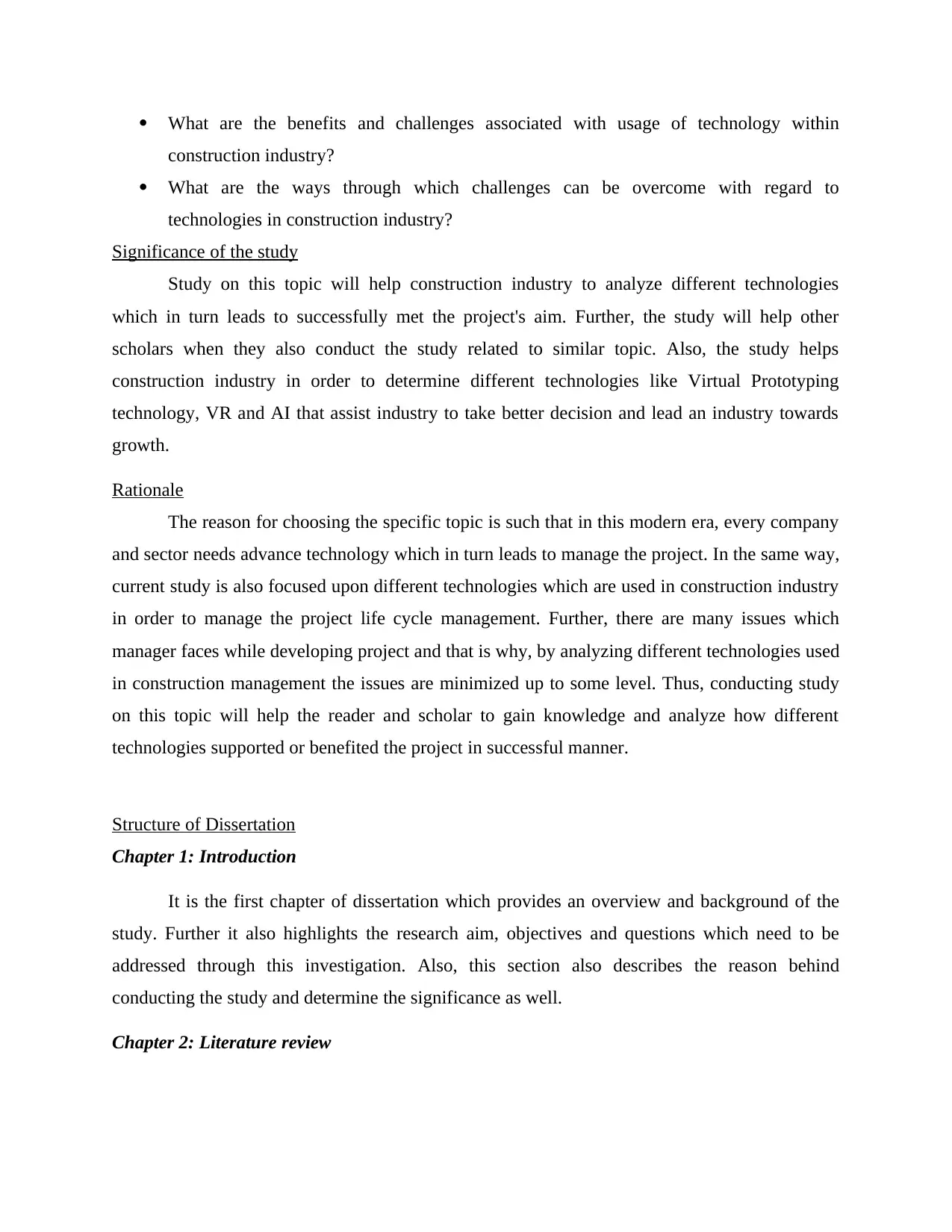
What are the benefits and challenges associated with usage of technology within
construction industry?
What are the ways through which challenges can be overcome with regard to
technologies in construction industry?
Significance of the study
Study on this topic will help construction industry to analyze different technologies
which in turn leads to successfully met the project's aim. Further, the study will help other
scholars when they also conduct the study related to similar topic. Also, the study helps
construction industry in order to determine different technologies like Virtual Prototyping
technology, VR and AI that assist industry to take better decision and lead an industry towards
growth.
Rationale
The reason for choosing the specific topic is such that in this modern era, every company
and sector needs advance technology which in turn leads to manage the project. In the same way,
current study is also focused upon different technologies which are used in construction industry
in order to manage the project life cycle management. Further, there are many issues which
manager faces while developing project and that is why, by analyzing different technologies used
in construction management the issues are minimized up to some level. Thus, conducting study
on this topic will help the reader and scholar to gain knowledge and analyze how different
technologies supported or benefited the project in successful manner.
Structure of Dissertation
Chapter 1: Introduction
It is the first chapter of dissertation which provides an overview and background of the
study. Further it also highlights the research aim, objectives and questions which need to be
addressed through this investigation. Also, this section also describes the reason behind
conducting the study and determine the significance as well.
Chapter 2: Literature review
construction industry?
What are the ways through which challenges can be overcome with regard to
technologies in construction industry?
Significance of the study
Study on this topic will help construction industry to analyze different technologies
which in turn leads to successfully met the project's aim. Further, the study will help other
scholars when they also conduct the study related to similar topic. Also, the study helps
construction industry in order to determine different technologies like Virtual Prototyping
technology, VR and AI that assist industry to take better decision and lead an industry towards
growth.
Rationale
The reason for choosing the specific topic is such that in this modern era, every company
and sector needs advance technology which in turn leads to manage the project. In the same way,
current study is also focused upon different technologies which are used in construction industry
in order to manage the project life cycle management. Further, there are many issues which
manager faces while developing project and that is why, by analyzing different technologies used
in construction management the issues are minimized up to some level. Thus, conducting study
on this topic will help the reader and scholar to gain knowledge and analyze how different
technologies supported or benefited the project in successful manner.
Structure of Dissertation
Chapter 1: Introduction
It is the first chapter of dissertation which provides an overview and background of the
study. Further it also highlights the research aim, objectives and questions which need to be
addressed through this investigation. Also, this section also describes the reason behind
conducting the study and determine the significance as well.
Chapter 2: Literature review

Second chapter of dissertation in which brief thesis will be prepared by doing critical
evaluation of a topic by using books, Journals and scholarly articles. This chapter is considering
one of the most important chapter within a dissertation because it provides a critical evaluation
of the themes and this in turn helps to determine the results in better manner.
Chapter 3: Research Methodology
This chapter provides the methods through which the results are generated and for that
research type, approach, philosophies, data collection, sampling and analysis method are used.
Therefore, this chapter present the tools which in turn assist in investigation issue in the best
possible way.
Chapter 4: Findings
The fourth chapter of dissertation which is highly important because it entails the results
derived through research. So, in this chapter the themes and graphs will be prepared on the basis
of responses gather through primary investigation.
Chapter 5: Discussion
Fifth chapter of dissertation in which scholar supported the responses through literature
review and this assist to determine the actual results and answer the research questions as well.
Chapter 6: Conclusion and Recommendations
Final chapter which highlights summary that derived through investigation and also
conclusion will be drawn by taking into account research aim and objectives. Along with this,
different ways are also presented pertaining to technology within construction industry are
recommended in near future that will assist to enhancing organizational performance.
evaluation of a topic by using books, Journals and scholarly articles. This chapter is considering
one of the most important chapter within a dissertation because it provides a critical evaluation
of the themes and this in turn helps to determine the results in better manner.
Chapter 3: Research Methodology
This chapter provides the methods through which the results are generated and for that
research type, approach, philosophies, data collection, sampling and analysis method are used.
Therefore, this chapter present the tools which in turn assist in investigation issue in the best
possible way.
Chapter 4: Findings
The fourth chapter of dissertation which is highly important because it entails the results
derived through research. So, in this chapter the themes and graphs will be prepared on the basis
of responses gather through primary investigation.
Chapter 5: Discussion
Fifth chapter of dissertation in which scholar supported the responses through literature
review and this assist to determine the actual results and answer the research questions as well.
Chapter 6: Conclusion and Recommendations
Final chapter which highlights summary that derived through investigation and also
conclusion will be drawn by taking into account research aim and objectives. Along with this,
different ways are also presented pertaining to technology within construction industry are
recommended in near future that will assist to enhancing organizational performance.
⊘ This is a preview!⊘
Do you want full access?
Subscribe today to unlock all pages.

Trusted by 1+ million students worldwide
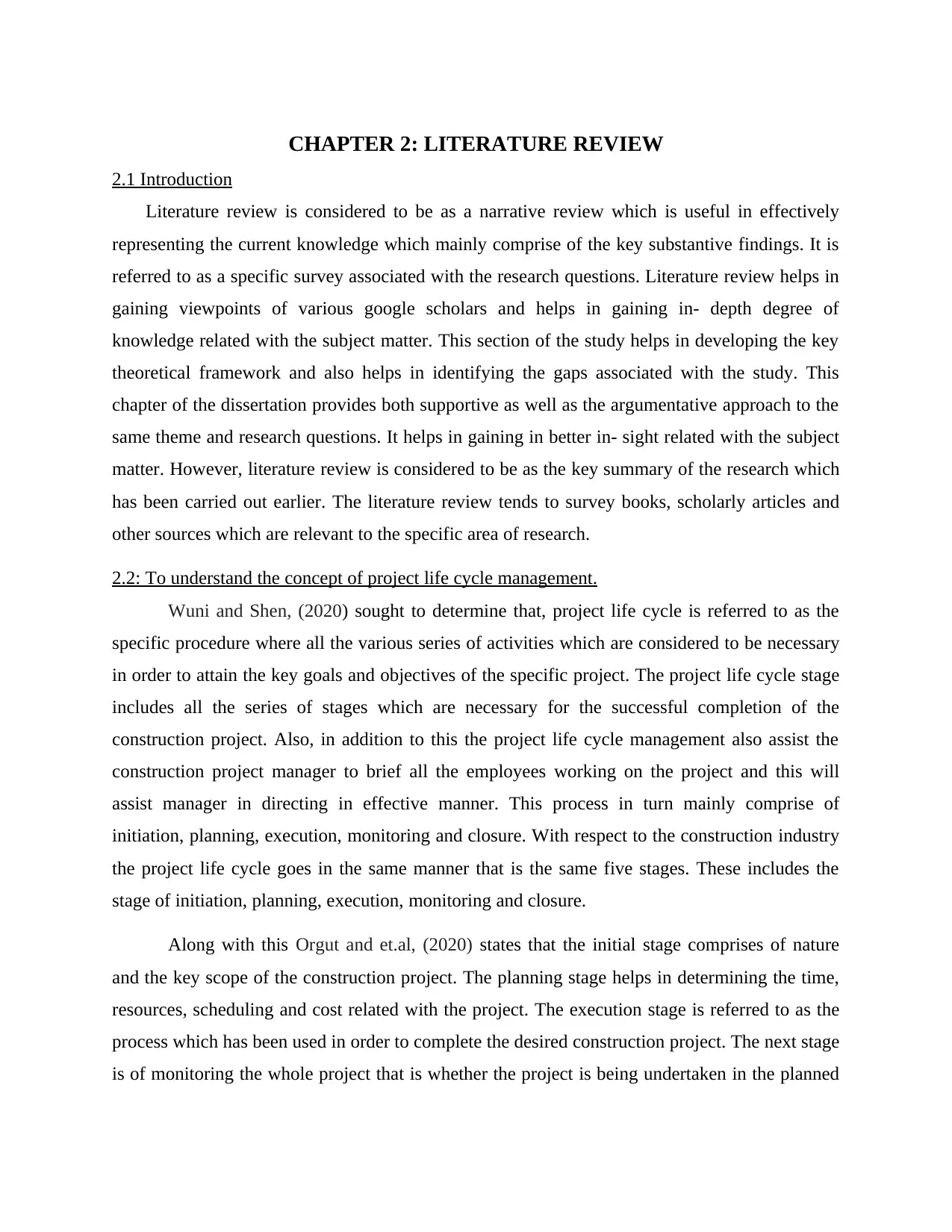
CHAPTER 2: LITERATURE REVIEW
2.1 Introduction
Literature review is considered to be as a narrative review which is useful in effectively
representing the current knowledge which mainly comprise of the key substantive findings. It is
referred to as a specific survey associated with the research questions. Literature review helps in
gaining viewpoints of various google scholars and helps in gaining in- depth degree of
knowledge related with the subject matter. This section of the study helps in developing the key
theoretical framework and also helps in identifying the gaps associated with the study. This
chapter of the dissertation provides both supportive as well as the argumentative approach to the
same theme and research questions. It helps in gaining in better in- sight related with the subject
matter. However, literature review is considered to be as the key summary of the research which
has been carried out earlier. The literature review tends to survey books, scholarly articles and
other sources which are relevant to the specific area of research.
2.2: To understand the concept of project life cycle management.
Wuni and Shen, (2020) sought to determine that, project life cycle is referred to as the
specific procedure where all the various series of activities which are considered to be necessary
in order to attain the key goals and objectives of the specific project. The project life cycle stage
includes all the series of stages which are necessary for the successful completion of the
construction project. Also, in addition to this the project life cycle management also assist the
construction project manager to brief all the employees working on the project and this will
assist manager in directing in effective manner. This process in turn mainly comprise of
initiation, planning, execution, monitoring and closure. With respect to the construction industry
the project life cycle goes in the same manner that is the same five stages. These includes the
stage of initiation, planning, execution, monitoring and closure.
Along with this Orgut and et.al, (2020) states that the initial stage comprises of nature
and the key scope of the construction project. The planning stage helps in determining the time,
resources, scheduling and cost related with the project. The execution stage is referred to as the
process which has been used in order to complete the desired construction project. The next stage
is of monitoring the whole project that is whether the project is being undertaken in the planned
2.1 Introduction
Literature review is considered to be as a narrative review which is useful in effectively
representing the current knowledge which mainly comprise of the key substantive findings. It is
referred to as a specific survey associated with the research questions. Literature review helps in
gaining viewpoints of various google scholars and helps in gaining in- depth degree of
knowledge related with the subject matter. This section of the study helps in developing the key
theoretical framework and also helps in identifying the gaps associated with the study. This
chapter of the dissertation provides both supportive as well as the argumentative approach to the
same theme and research questions. It helps in gaining in better in- sight related with the subject
matter. However, literature review is considered to be as the key summary of the research which
has been carried out earlier. The literature review tends to survey books, scholarly articles and
other sources which are relevant to the specific area of research.
2.2: To understand the concept of project life cycle management.
Wuni and Shen, (2020) sought to determine that, project life cycle is referred to as the
specific procedure where all the various series of activities which are considered to be necessary
in order to attain the key goals and objectives of the specific project. The project life cycle stage
includes all the series of stages which are necessary for the successful completion of the
construction project. Also, in addition to this the project life cycle management also assist the
construction project manager to brief all the employees working on the project and this will
assist manager in directing in effective manner. This process in turn mainly comprise of
initiation, planning, execution, monitoring and closure. With respect to the construction industry
the project life cycle goes in the same manner that is the same five stages. These includes the
stage of initiation, planning, execution, monitoring and closure.
Along with this Orgut and et.al, (2020) states that the initial stage comprises of nature
and the key scope of the construction project. The planning stage helps in determining the time,
resources, scheduling and cost related with the project. The execution stage is referred to as the
process which has been used in order to complete the desired construction project. The next stage
is of monitoring the whole project that is whether the project is being undertaken in the planned
Paraphrase This Document
Need a fresh take? Get an instant paraphrase of this document with our AI Paraphraser
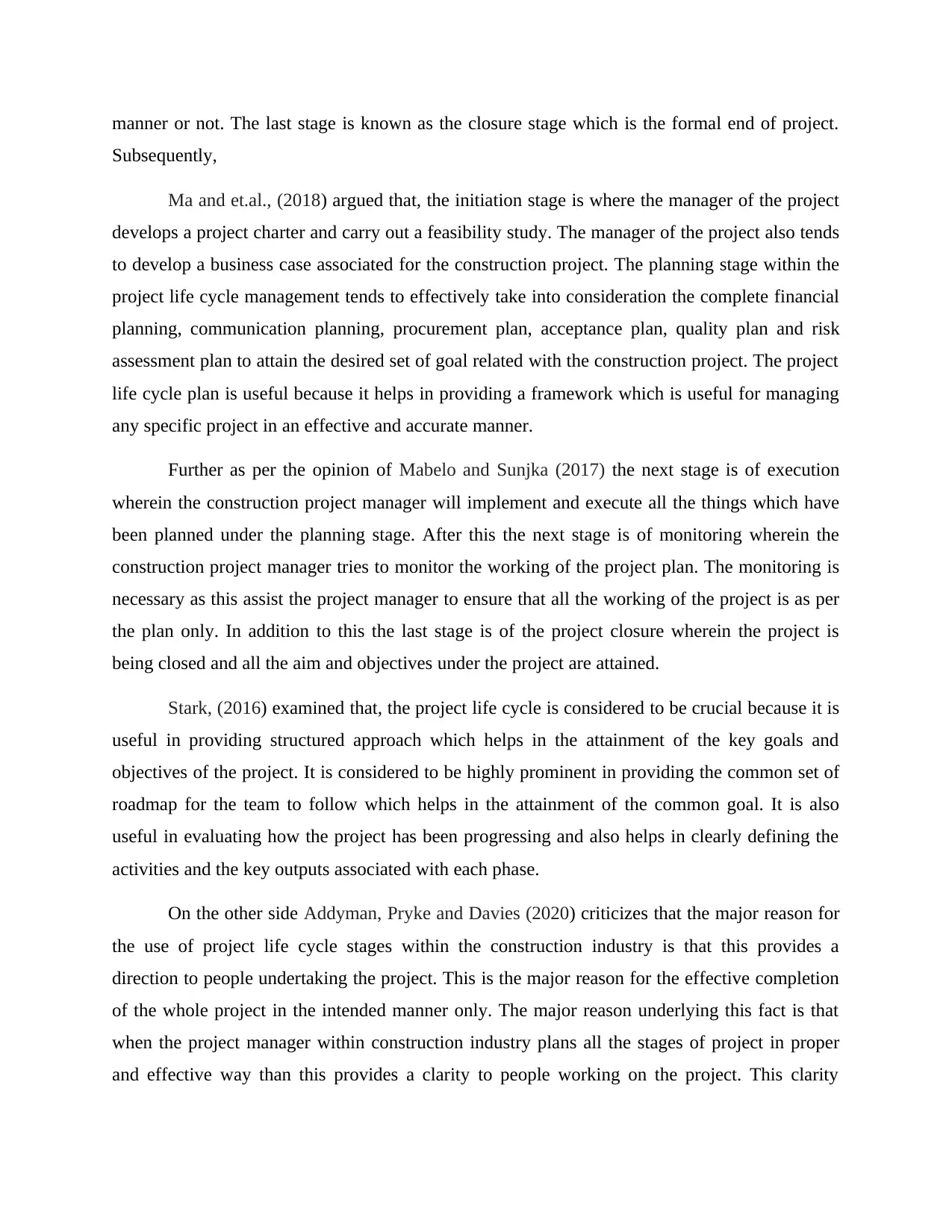
manner or not. The last stage is known as the closure stage which is the formal end of project.
Subsequently,
Ma and et.al., (2018) argued that, the initiation stage is where the manager of the project
develops a project charter and carry out a feasibility study. The manager of the project also tends
to develop a business case associated for the construction project. The planning stage within the
project life cycle management tends to effectively take into consideration the complete financial
planning, communication planning, procurement plan, acceptance plan, quality plan and risk
assessment plan to attain the desired set of goal related with the construction project. The project
life cycle plan is useful because it helps in providing a framework which is useful for managing
any specific project in an effective and accurate manner.
Further as per the opinion of Mabelo and Sunjka (2017) the next stage is of execution
wherein the construction project manager will implement and execute all the things which have
been planned under the planning stage. After this the next stage is of monitoring wherein the
construction project manager tries to monitor the working of the project plan. The monitoring is
necessary as this assist the project manager to ensure that all the working of the project is as per
the plan only. In addition to this the last stage is of the project closure wherein the project is
being closed and all the aim and objectives under the project are attained.
Stark, (2016) examined that, the project life cycle is considered to be crucial because it is
useful in providing structured approach which helps in the attainment of the key goals and
objectives of the project. It is considered to be highly prominent in providing the common set of
roadmap for the team to follow which helps in the attainment of the common goal. It is also
useful in evaluating how the project has been progressing and also helps in clearly defining the
activities and the key outputs associated with each phase.
On the other side Addyman, Pryke and Davies (2020) criticizes that the major reason for
the use of project life cycle stages within the construction industry is that this provides a
direction to people undertaking the project. This is the major reason for the effective completion
of the whole project in the intended manner only. The major reason underlying this fact is that
when the project manager within construction industry plans all the stages of project in proper
and effective way than this provides a clarity to people working on the project. This clarity
Subsequently,
Ma and et.al., (2018) argued that, the initiation stage is where the manager of the project
develops a project charter and carry out a feasibility study. The manager of the project also tends
to develop a business case associated for the construction project. The planning stage within the
project life cycle management tends to effectively take into consideration the complete financial
planning, communication planning, procurement plan, acceptance plan, quality plan and risk
assessment plan to attain the desired set of goal related with the construction project. The project
life cycle plan is useful because it helps in providing a framework which is useful for managing
any specific project in an effective and accurate manner.
Further as per the opinion of Mabelo and Sunjka (2017) the next stage is of execution
wherein the construction project manager will implement and execute all the things which have
been planned under the planning stage. After this the next stage is of monitoring wherein the
construction project manager tries to monitor the working of the project plan. The monitoring is
necessary as this assist the project manager to ensure that all the working of the project is as per
the plan only. In addition to this the last stage is of the project closure wherein the project is
being closed and all the aim and objectives under the project are attained.
Stark, (2016) examined that, the project life cycle is considered to be crucial because it is
useful in providing structured approach which helps in the attainment of the key goals and
objectives of the project. It is considered to be highly prominent in providing the common set of
roadmap for the team to follow which helps in the attainment of the common goal. It is also
useful in evaluating how the project has been progressing and also helps in clearly defining the
activities and the key outputs associated with each phase.
On the other side Addyman, Pryke and Davies (2020) criticizes that the major reason for
the use of project life cycle stages within the construction industry is that this provides a
direction to people undertaking the project. This is the major reason for the effective completion
of the whole project in the intended manner only. The major reason underlying this fact is that
when the project manager within construction industry plans all the stages of project in proper
and effective way than this provides a clarity to people working on the project. This clarity
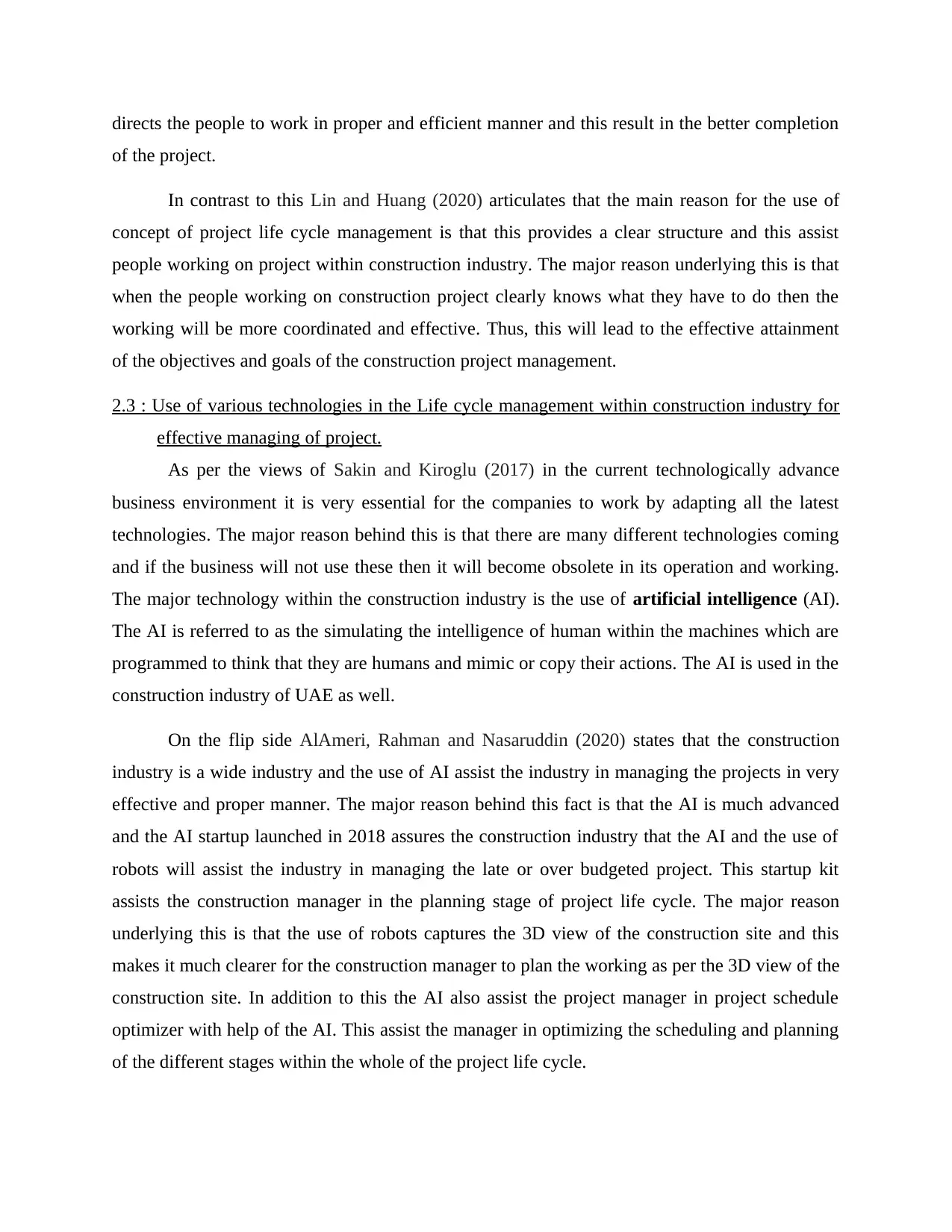
directs the people to work in proper and efficient manner and this result in the better completion
of the project.
In contrast to this Lin and Huang (2020) articulates that the main reason for the use of
concept of project life cycle management is that this provides a clear structure and this assist
people working on project within construction industry. The major reason underlying this is that
when the people working on construction project clearly knows what they have to do then the
working will be more coordinated and effective. Thus, this will lead to the effective attainment
of the objectives and goals of the construction project management.
2.3 : Use of various technologies in the Life cycle management within construction industry for
effective managing of project.
As per the views of Sakin and Kiroglu (2017) in the current technologically advance
business environment it is very essential for the companies to work by adapting all the latest
technologies. The major reason behind this is that there are many different technologies coming
and if the business will not use these then it will become obsolete in its operation and working.
The major technology within the construction industry is the use of artificial intelligence (AI).
The AI is referred to as the simulating the intelligence of human within the machines which are
programmed to think that they are humans and mimic or copy their actions. The AI is used in the
construction industry of UAE as well.
On the flip side AlAmeri, Rahman and Nasaruddin (2020) states that the construction
industry is a wide industry and the use of AI assist the industry in managing the projects in very
effective and proper manner. The major reason behind this fact is that the AI is much advanced
and the AI startup launched in 2018 assures the construction industry that the AI and the use of
robots will assist the industry in managing the late or over budgeted project. This startup kit
assists the construction manager in the planning stage of project life cycle. The major reason
underlying this is that the use of robots captures the 3D view of the construction site and this
makes it much clearer for the construction manager to plan the working as per the 3D view of the
construction site. In addition to this the AI also assist the project manager in project schedule
optimizer with help of the AI. This assist the manager in optimizing the scheduling and planning
of the different stages within the whole of the project life cycle.
of the project.
In contrast to this Lin and Huang (2020) articulates that the main reason for the use of
concept of project life cycle management is that this provides a clear structure and this assist
people working on project within construction industry. The major reason underlying this is that
when the people working on construction project clearly knows what they have to do then the
working will be more coordinated and effective. Thus, this will lead to the effective attainment
of the objectives and goals of the construction project management.
2.3 : Use of various technologies in the Life cycle management within construction industry for
effective managing of project.
As per the views of Sakin and Kiroglu (2017) in the current technologically advance
business environment it is very essential for the companies to work by adapting all the latest
technologies. The major reason behind this is that there are many different technologies coming
and if the business will not use these then it will become obsolete in its operation and working.
The major technology within the construction industry is the use of artificial intelligence (AI).
The AI is referred to as the simulating the intelligence of human within the machines which are
programmed to think that they are humans and mimic or copy their actions. The AI is used in the
construction industry of UAE as well.
On the flip side AlAmeri, Rahman and Nasaruddin (2020) states that the construction
industry is a wide industry and the use of AI assist the industry in managing the projects in very
effective and proper manner. The major reason behind this fact is that the AI is much advanced
and the AI startup launched in 2018 assures the construction industry that the AI and the use of
robots will assist the industry in managing the late or over budgeted project. This startup kit
assists the construction manager in the planning stage of project life cycle. The major reason
underlying this is that the use of robots captures the 3D view of the construction site and this
makes it much clearer for the construction manager to plan the working as per the 3D view of the
construction site. In addition to this the AI also assist the project manager in project schedule
optimizer with help of the AI. This assist the manager in optimizing the scheduling and planning
of the different stages within the whole of the project life cycle.
⊘ This is a preview!⊘
Do you want full access?
Subscribe today to unlock all pages.

Trusted by 1+ million students worldwide
1 out of 69
Related Documents
Your All-in-One AI-Powered Toolkit for Academic Success.
+13062052269
info@desklib.com
Available 24*7 on WhatsApp / Email
![[object Object]](/_next/static/media/star-bottom.7253800d.svg)
Unlock your academic potential
Copyright © 2020–2025 A2Z Services. All Rights Reserved. Developed and managed by ZUCOL.





